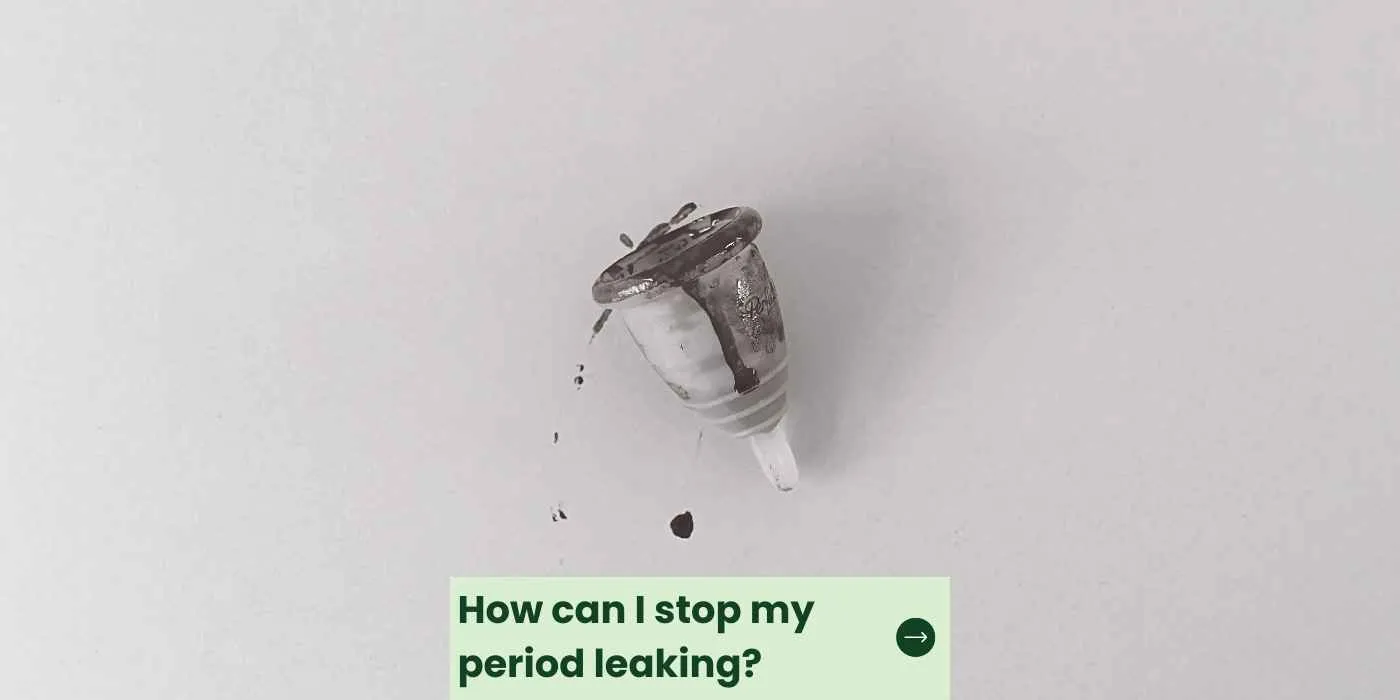Dealing with period leaking can be a source of anxiety and discomfort. It’s a concern many women face, looking for effective ways to manage their menstrual flow, especially during active days or while sleeping.
In this comprehensive guide, we’ll delve into various strategies to prevent menstrual leaks. We’ll explore the best practices in choosing and using menstrual products like tampons, pads, menstrual cups, or period-proof underwear. We’ll provide insights into lifestyle and dietary adjustments that can help in managing a heavier flow.
Understanding your cycle, being prepared with the right products, and knowing some practical tips can make a significant difference. Let’s navigate these solutions together for a more comfortable and confident period experience.
Key Takeaways: Stopping Period Leaking
- Use the right absorbency tampon or pad. Matching the absorbency level to your flow reduces the risk of leaks.
- Consider menstrual cups for longer protection. Menstrual cups can hold more fluid than tampons or pads and offer up to 12 hours of protection.
- Wear period-proof underwear for extra security. This special underwear has extra layers to prevent leaks and can be worn alone or with other products.
- Change your tampon, pad, or cup regularly. Regular changing, every 4-6 hours, helps prevent leaks and maintains hygiene.
- Try a backup method during heavy flow days. Using a pad with a tampon or cup provides an additional layer of protection.
- Adjust the product positioning for a better fit. Proper positioning ensures maximum coverage and leak prevention.
- Stay prepared with spare supplies. Keeping extra pads, tampons, or underwear on hand helps you respond quickly to unexpected leaks.
Understanding Menstrual Flow Characteristics
Understanding the characteristics of menstrual flow is key to managing your period effectively and comfortably. Each woman’s experience with menstruation is unique, but there are common aspects that can help you better comprehend and manage your cycle.
Recognizing Patterns in Your Menstrual Cycle: Being familiar with your menstrual cycle is crucial. A typical cycle lasts between 21 to 35 days, with menstruation lasting from 2 to 7 days. Tracking your cycle can help you identify patterns, like the heaviness of flow on certain days or accompanying symptoms like cramps.
This awareness aids in anticipating your needs, such as when to wear heavier absorbency products or to expect potential discomfort. Nowadays, there are numerous apps and tools available to track menstrual cycles, making it easier to recognize and prepare for your period.
Things to Consider:
- The regularity and length of your cycle
- Changes in flow intensity over the course of your period
- Accompanying symptoms like cramps, mood swings, or fatigue
Differentiating Between Types of Flow: Menstrual flow can vary from light to heavy and change throughout the period. Light flow might require a panty liner or a small pad, while heavy flow often requires larger, more absorbent pads or tampons.
It’s not unusual for the first couple of days to have a heavier flow, which then gradually becomes lighter. Understanding these variations can help in choosing the right products and in being prepared for different days of your cycle.
Things to Consider:
- The type of sanitary products suited for various flow levels
- The need for different products on different days of your period
- Being prepared for sudden changes in flow
It’s important to be mindful of any significant changes in your menstrual flow, such as an unusually heavy flow or a sudden shift in cycle regularity. These could be signs of underlying health issues and might necessitate a consultation with a healthcare provider. Remember, being well-informed about your menstrual flow is a step towards better menstrual health and comfort.
Selecting the Right Menstrual Hygiene Products
When it comes to menstrual hygiene, there’s a variety of products available, each with its unique benefits.
- Pads are a popular choice, known for their ease of use and availability in different sizes and absorbencies.
- Tampons, on the other hand, are preferred for their discreetness and suitability for active lifestyles.
- Menstrual cups have gained popularity for being eco-friendly and cost-effective, as they can be reused.
- Period panties are an innovative solution, offering comfort and leakage protection, and they’re great for those who prioritize sustainability. It’s important to explore each type to find what works best for your lifestyle and comfort.
| Menstrual Product Type | Absorbency Levels | Suitable Activities | Notes |
|---|---|---|---|
| Pads | Light, Regular, Super, Overnight | Low to moderate activities, sleeping | Available in different sizes and shapes. |
| Tampons | Light, Regular, Super, Super Plus | Moderate to high activities, swimming | Requires changing every 4-6 hours. |
| Menstrual Cups | Small, Large (based on capacity) | All activities, including swimming and sports | Can be worn up to 12 hours, reusable. |
| Period Underwear | Light, Moderate, Heavy, Overnight | Low to high activities, sleeping | Reusable, different styles available. |
| Menstrual Discs | Standard (3-4 tampons capacity) | All activities, including high-impact sports | Single use, worn up to 12 hours. |
| Reusable Cloth Pads | Light, Regular, Heavy, Overnight | Low to moderate activities, sleeping | Eco-friendly, requires regular washing. |
Notes for Table Interpretation:
- Absorbency Levels: Defined by the capacity to absorb menstrual flow. Lighter absorbency is suitable for lighter flow days or for those with a generally light flow, while higher absorbency is needed for heavier flow days or for individuals with a heavier menstrual flow.
- Suitable Activities: Indicates the type of physical activity each product is best suited for. Some products, like tampons and menstrual cups, are more versatile and can be used during high-impact sports and swimming, while others, like pads, might be more comfortable for lower-intensity activities or rest periods.
Appropriate Sizing and Fit: How to Choose for Maximum Protection
Selecting the right size and fit is crucial for comfort and leak protection. For pads, consider the length and width that suits your body shape and menstrual flow. A snug fit is essential for tampons to prevent leaks and ensure comfort.
If you’re leaning towards menstrual cups, they come in different sizes based on factors like age, childbirth history, and flow volume. For period panties, make sure to refer to the brand’s sizing chart for the best fit. Remember, the right size not only offers better protection but also ensures you feel secure and comfortable during your period.
Correct Usage: Techniques for Proper Application and Positioning
Using menstrual hygiene products correctly is key to maximizing their effectiveness. When using pads, make sure to place them firmly in your underwear, aligning them with your body for optimal coverage.
For tampons, learning the correct insertion technique is important for both comfort and leak prevention. Menstrual cups require a bit more practice; they should be folded for insertion and positioned so they unfold completely inside.
With period panties, it’s as simple as wearing them like regular underwear. Always check the product’s instructions for detailed guidance to ensure you’re using them effectively.
Absorbency and Quality: Choosing Products Based on Individual Flow Needs
Absorbency is a vital factor when selecting menstrual hygiene products. Light, regular, and super are common absorbency levels you’ll find in pads and tampons, catering to different flow intensities. For menstrual cups, consider the cup’s volume capacity, especially if you have a heavier flow. With period panties, look for ones with good absorbent layers.
Quality is just as important; higher quality products not only offer better protection but are also gentler on your skin. It’s worth investing in products that match your flow needs and offer the quality you deserve for a worry-free period experience.
Remember, when choosing menstrual hygiene products, consider your lifestyle, comfort, and menstrual flow. Each product has its own set of advantages, and it’s about finding what works best for you. Stay informed about the options available, and don’t hesitate to try different products to find your perfect fit. Your menstrual health and comfort are paramount, so choose wisely for a more comfortable and stress-free period.
How can I stop my period leaking? Practical Strategies for Menstrual Leakage Prevention
Dealing with menstrual leakage can be challenging, but there are several practical strategies that can make this time of the month more comfortable and stress-free. Understanding these methods can help you feel more confident and prepared.
Choosing the Right Products: The first step in preventing menstrual leakage is selecting the right sanitary products for your needs. Pads, tampons, menstrual cups, and period panties are all popular options, each with their unique advantages.
Pads are great for those who prefer an external method, while tampons and menstrual cups are ideal for a more active lifestyle. Period panties offer an extra layer of protection and are perfect for overnight use or on heavier days. When choosing a product, consider factors like your flow, comfort, and activity level. It’s also beneficial to have a variety of products on hand to suit different needs throughout your cycle.
Things to Consider:
- Your menstrual flow: Light, medium, or heavy
- The duration of your period
- Your level of physical activity
- Personal comfort and preferences
Regularly changing your chosen product is vital in preventing leakage. For tampons and pads, changing them every 4-6 hours is recommended, but this may vary based on your flow. Menstrual cups can be worn for up to 12 hours, but it’s essential to empty and clean them as directed.
- Pads:
- Light: Suitable for light flow or spotting.
- Regular: For moderate flow.
- Super: For heavy flow.
- Overnight: Extra-long and absorbent for nighttime use.
- Tampons:
- Light: Less absorbency, suitable for light flow.
- Regular: Standard absorbency for moderate flow.
- Super: Higher absorbency for heavy flow.
- Super Plus: Very high absorbency, for very heavy flow.
- Menstrual Cups:
- Cups are measured more by capacity than absorbency. They come in different sizes, usually small (for those under 30 who haven’t given birth vaginally) and large (for those over 30 or who have given birth vaginally).
- Period Underwear:
- Light: Holds up to 1 tampon’s worth.
- Moderate: Holds up to 2 tampons’ worth.
- Heavy: Holds up to 3 tampons’ worth.
- Overnight: Designed for all-night protection, capacity varies by brand.
- Menstrual Discs:
- Similar to cups, discs are measured by capacity. They typically hold the equivalent of 3-4 tampons worth of menstrual flow.
- Reusable Cloth Pads:
- Light: For light flow or as a backup for a cup/disc.
- Regular: Standard absorbency for moderate flow.
- Heavy: For heavier flow days.
- Overnight: Larger and more absorbent for nighttime use.
Lifestyle and Dietary Adjustments: Believe it or not, your lifestyle and diet can impact menstrual leakage. Staying hydrated, maintaining a balanced diet, and engaging in regular exercise can help regulate your cycle and potentially reduce flow intensity. Foods rich in omega-3 fatty acids, iron, and vitamins can be particularly beneficial during your period. Reducing caffeine and salty foods can also help minimize bloating and discomfort, which can indirectly help manage leakage.
Things to Consider:
- Your hydration levels
- Incorporating a balanced diet with essential nutrients
- The impact of caffeine and salt on your body during menstruation
Remember, every woman’s body is different, so it might take some trial and error to find what works best for you.
Lifestyle and Behavioral Factors Influencing Menstrual Leakage
Menstrual leakage is a common experience for many women, often causing discomfort and inconvenience. Understanding the lifestyle and behavioral factors that can influence this issue is key to managing and possibly reducing its occurrence.
One significant factor is physical activity. High-impact exercises, such as running or jumping, can increase the likelihood of menstrual leakage. This is due to the added pressure these activities place on the pelvic floor muscles.
Women who engage in intense workouts might consider moderating their exercise routine or opting for low-impact activities like yoga or swimming during their periods. It’s also beneficial to strengthen the pelvic floor muscles through exercises like Kegels, which can help in reducing leakage.
Diet plays a crucial role too. Certain foods and beverages can exacerbate menstrual symptoms and potentially increase leakage. For example, caffeine and alcohol can lead to increased bloating and fluid retention, making the body more prone to leakage.
Incorporating a balanced diet rich in fruits, vegetables, and whole grains can not only improve overall health but also potentially alleviate some menstrual symptoms. Staying hydrated is crucial, but it’s wise to limit caffeine and alcohol intake, especially around your menstrual cycle.
Stress management is another vital aspect. High levels of stress can disrupt hormonal balance, affecting the menstrual cycle and potentially increasing the risk of leakage.
Practices such as mindfulness, meditation, and adequate sleep can help in managing stress levels. Creating a calm and relaxing environment, particularly during menstruation, can also have positive effects on your cycle.
FAQs on Why Do I Leak on My Period
Is it normal to leak on your period?
Absolutely! Leaking while on your period is incredibly common, especially during your first period while you are getting used to how your body works. That said, it happens to all of us at some time or other, and, for some people, can be a regular hindrance.
The best way to prevent period leaks during the day is to pay close attention to your menstrual cycle and get to know your menstrual flow. Something as simple as swapping to a longer pad or changing to a different product may be the solution.
Why does my period blood leak to the back?
This will be down to your own body movements, and is particularly common at night, and for those who experience heavier periods.
If you seem to leak to the back, add some extra coverage to the back. Wearing tampons or using a menstrual cup might also help, particularly if you have a heavy flow. Whether you are using a pad or tampon, try to increase absorbency.
When I stand up my period gushes?
Again, an annoying but very common phenomenon! The best way to get around this is again to use an internally worn method of period protection, such as tampons or a menstrual cup. These gather the menstrual flow inside, so you shouldn’t have that horrible sensation when you stand up!
Alternatively, it’s probably best to carry an extra pair of underwear and an extra pad with you so that you’re at least prepared to deal with any unprecedented period leakage.
What causes heavy menstrual flow?
We all have our own unique bodies and hormones, and it seems that many girls tend to take after their mothers in terms of onset of the first period, along with period heaviness.
Heavy periods aren’t an issue for your well being as such- unless you find that you are feeling unwell, unable to manage daily activities or are bleeding very excessively, saturating pads within an hour or two, for example. If you think you might be impacted by heavy periods, speak to your gp to discuss medical solutions- medications such as birth control can be prescribed to help, improving well being.
If your flow is heavy, double up
Don’t get caught out finding yourself having to use toilet paper as a booster to your period product of choice- you can prevent period leaks by doubling up on products, for example wearing a tampon or cup, and a night time pad as a back up.
Period pants are a great back up, whether your wear tampons, a cup or indeed a pad- simply place a pad in to the pats, and when that needs changing, you can either replace with a new pad or just rely on the period pants to do their thing alone!
Why is my period heavier at night?
Period leaks are common, especially at night. This isn’t necessarily because your period flow is heavier, but because you are laying down- the blood flows differently to what you’re used to during the day.
Additionally, where you change your pad frequently doing the day and also feel the menstrual fluid fall, as you sleep soundly you have no awareness that your period protection is reaching is limit and that a period leak is imminent!
When you get up in the morning, period leaks are common because the blood can gush. It’s therefore best to get up slowly.
How do you stop your period leaking at night?
Here are a few general tips to prevent those annoying period leaks:
- To prevent period leaks, always change your pad, period panties or tampon right before bed.
- Use extra precautions such as a mattress protector or dark towel to prevent blood stains on your mattress or bed sheet. Stained underwear is also less of an issue if you opt for dark undies!
- Be aware of where you are in your menstrual cycle, and choose the right absorbency period product to suit. A night time pad is often the best idea for the extra length.
- Your body movements are important, so try swapping your sleeping positions- try laying on your side with knees together and tucked to your abdominal muscles.








